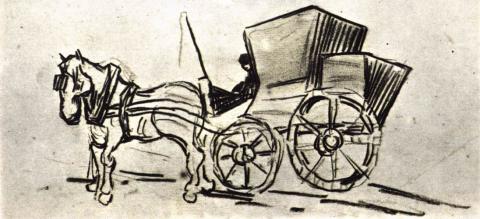-
Table of Contents
- 0. STORY PREFACE
- 1. EARLY LIFE
- 2. AN ARTIST IS BORN
- 3. STUDYING ART, FEELING PAIN
- 4. THE FIRST MASTERPIECE
- 5. THE PARIS YEARS
- 6. INFLUENCE of JAPANESE ART
- 7. EARLY LIFE in ARLES
- 8. THE BANDAGED EAR
- 9. VINCENT at SAINT-REMY
- 10. THE ATTACKS CONTINUE
- 11. PAINTING in AUVERS-sur-OISE
- 12. WORRIES and TURMOIL
- 13. VINCENT COMMITS SUICIDE
- 14. THE SADNESS WILL LAST FOREVER
 Back
Back
 Next Chapter
Next Chapter
In addition to his many oil-on-canvas paintings, Vincent created watercolors and drawings. This image depicts one of his last lead-pencil drawings—“Carriage Drawn by a Horse—which he produced between June and July of 1890, while living in Auvers-sur-Oise. It measures 216 x 254 mm and is currently maintained by the van Gogh Museum in Amsterdam. Click on the image for a better view.
Describing Vincent's funeral to their mother, Theo wondered whether his brother ever really knew how people felt about him:
If he could have seen how people behaved toward me when he had left us and the sympathy of so many for himself, he would at this moment not have wanted to die . . . Life weighed so heavily upon him, but as happens so often everyone is now full of praise, also for his talent. (Theo's letter to his Mother, 1 August 1890.)
Even his last hours were troubled, however, as the local police investigated what had happened. Emile Bernard:
The coffin was already closed, I arrived too late to see the man again who had left me four years ago so full of expectations of all kinds ... The innkeeper told us all the details of the accident, the offensive visit of the gendarmes who even went up to his bedside to reproach him for an act for which he alone was responsible ... etc ... (Emile Bernard, August 2nd letter.)
At his funeral, people noted the "brilliance of the genius that radiated from" his paintings:
On the walls of the room where his body was laid out all his last canvases were hung making a sort of halo for him and the brilliance of the genius that radiated from them made this death even more painful for us artists who were there. The coffin was covered with a simple white cloth and surrounded with masses of flowers, the sunflowers that he loved so much, yellow dahlias, yellow flowers everywhere. It was, you will remember, his favourite colour, the symbol of the light that he dreamed of as being in people's hearts as well as in works of art. (Emile Bernard, August 2nd letter.)
Many people attended Vincent's funeral:
Many people arrived, mainly artists, among whom I recognized Lucien Pissarro and Lauzet, the others I did not know, also some local people who had known him a little, seen him once or twice and who liked him because he was so good-hearted, so human.
It was a beautiful, warm day - one that van Gogh would likely have used to create another beautiful painting:
. . .The sun was terribly hot outside. We climbed the hill outside Auvers talking about him, about the daring impulse he had given to art, of the great projects he was always thinking about, and of the good he had done to all of us.
. . .Anyone would have started crying at that moment ... the day was too much made for him for one not to imagine that he was still alive and enjoying it ...
. . .He was, Gachet said, an honest man and a great artist, he had only two aims, humanity and art. It was art that he prized above everything and which will make his name live.
Earlier in 1890, Theo told his brother success would surely come in his lifetime:
I think we can wait patiently for success to come; you will surely live to see it. It is necessary to get well known without obtruding oneself, and it will come of its own accord by reason of your beautiful pictures. (Theo to Vincent, 22 January 1890.)
Success came, but it was after both Vincent and Theo were gone. In poor health himself, van Gogh's younger brother died six months after Vincent's suicide. They are buried side-by-side.
Jo - Theo's widow - inherited Vincent's art and worked very hard to promote it after Vincent's death. Ironically, van Gogh's drawings became commercially successful before his paintings.
In today's world, Vincent's art is so desirable it is rarely available for purchase. When a painting does come on the market, it commands "top dollar" prices:
| Vase with Fifteen Sunflowers - sold March 30, 1987 |
$39.5 million |
| Irises - sold November, 1987 |
$53.9 million |
| Portrait of Doctor Gachet - sold May 15, 1990 |
$82.5 million |
| Self-Portrait (Without Beard) - sold Nov 19, 1998 |
$71.5 million |
| TOTAL - FOUR PAINTINGS | $247.4 million |
Vincent didn't "live to see it," as Theo had predicted. But his heirs, through Theo's son, did. And from that work, the van Gogh Foundation helped to establish the van Gogh Museum (which opened in Amsterdam during 1973).
-
Table of Contents
- 0. STORY PREFACE
- 1. EARLY LIFE
- 2. AN ARTIST IS BORN
- 3. STUDYING ART, FEELING PAIN
- 4. THE FIRST MASTERPIECE
- 5. THE PARIS YEARS
- 6. INFLUENCE of JAPANESE ART
- 7. EARLY LIFE in ARLES
- 8. THE BANDAGED EAR
- 9. VINCENT at SAINT-REMY
- 10. THE ATTACKS CONTINUE
- 11. PAINTING in AUVERS-sur-OISE
- 12. WORRIES and TURMOIL
- 13. VINCENT COMMITS SUICIDE
- 14. THE SADNESS WILL LAST FOREVER
 Back
Back
 Next Chapter
Next Chapter





